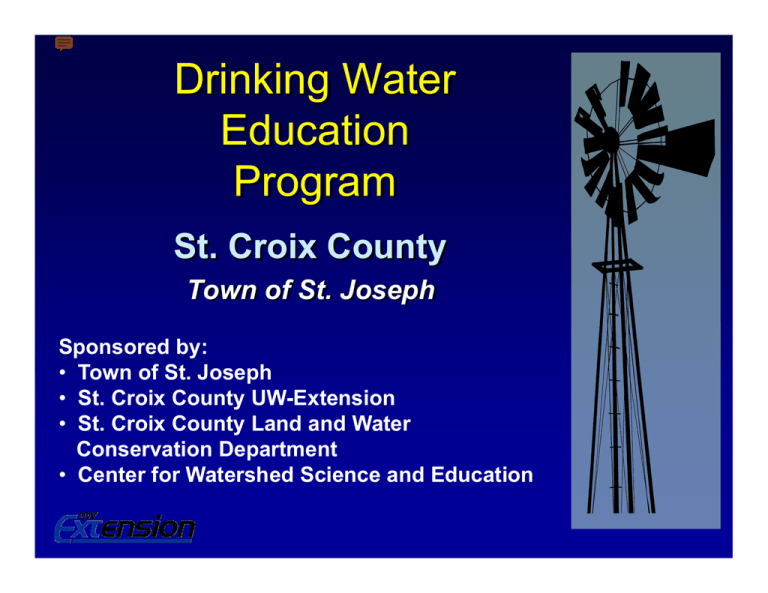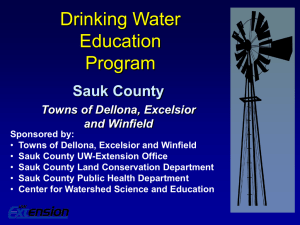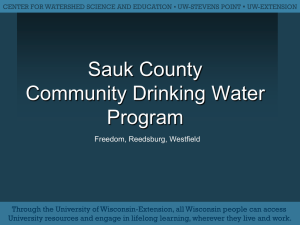Drinking Water Education Program St. Croix County
advertisement

Drinking Water Education Program St. Croix County Town of St. Joseph Sponsored by: • Town of St. Joseph • St. Croix County UW-Extension • St. Croix County Land and Water Conservation Department • Center for Watershed Science and Education Today’s presentation ¾ What is groundwater and where does it come from? ¾ What do my individual test results mean? ¾ General groundwater quality in the Town of St. Joseph. ¾ Improving your water quality The Water Cycle Precipitation Transpiration Infiltration Runoff Evaporation Percolation Well Water Table Groundwater Runoff River Impermeable bedrock Groundwater flow Impermeable bedrock Groundwater Movement Groundwater Movement St.Croix County Geology Aquifer – (n.) A water bearing geological formation. Soil Private vs. Public Water Supplies Public Water Supplies ¾Regularly tested and regulated by drinking water standards. Private Wells ¾Not required to be regularly tested. ¾Not required to take corrective action ¾Owners must take special precautions to ensure safe drinking water. Why do people test their water? ¾ ¾ ¾ ¾ ¾ Installed a new well Change in taste or odor Buying or selling their home Plumbing issues Want to know if it’s safe to drink. What are the Health Concerns? ¾ Acute Effects – Usually seen within a short time after exposure to a substance. (ex. Bacterial contamination may cause intestinal disease) ¾ Chronic Effects – Results from exposure to a substance over a long period of time. (ex. Arsenic or pesticides can increase the chance of developing certain types of cancer) No one test tells us everything we need to know about the safety and condition of a water supply Interpreting Drinking Water Test Results Tests important to health: ¾ ¾ ¾ ¾ ¾ ¾ ¾ ¾ ¾ Coliform bacteria Sodium Nitrate Copper Lead Triazine Zinc Sulfate Arsenic Tests for aesthetic (taste,color,odor) problems: ¾ Hardness ¾ Iron ¾ Manganese ¾ Chloride Other important indicator tests: ¾ ¾ ¾ ¾ Saturation Index Alkalinity Conductivity Potassium Red = human-influenced, Blue = naturally found Laboratory Results: Homeowners Package: Bacteria-Coliform Hardness-Total Alkalinity Conductivity Absent 357 326 724 mg/l CaCO3 mg/l CaCO3 umhos/cm Homeowners Metal Package: Arsenic (VISTA-ICP) Less Than 0.005 Calcium 0.5 Copper (VISTA-ICP) 0.031 Iron (VISTA-ICP) 0.065 Lead (VISTA-ICP) 0.016 mg/l (None Detected mg/l mg/l mg/l mg/l Pesticides: Triazine Screen 0.2 ppb milligrams per liter (mg/l) = parts per million (ppm) 1 mg/l = 1000 parts per billion (ppb) Coliform bacteria ¾ Coliform bacteria may indicate the presence of more harmful bacteria with similar life cycles. ¾ Harmful bacteria can cause gastrointestinal disease, cholera, hepatitis ¾ If any is present assume that the water is unsafe Present =Unsafe ¾ Sources: Absent = Safe z z z Live in soils and on vegetation Human and animal waste Sampling error E.coli bacteria ¾ Type of bacteria found in the intestines of warm-blooded animals and their feces are called E.coli. ¾ E.coli are often present with harmful bacteria, viruses and parasites that can cause serious gastrointestinal illnesses. ¾ Any detectable level of E.coli means your water is unsafe to drink. What should I do if I have Bacteria Problems? Use alternative source of water for drinking 2. Retest 3. Try to identify any sanitary defects 1. z z z z Loose or non-existent well cap Well construction faults Abandoned well Inadequate filtration by soil 4. Disinfect the well 5. Retest to ensure well is bacteria free. ¾ For reoccurring bacteria problems it may be necessary to look into drilling a new well. Rock and Soil Impacts on Water Quality Tests for Aesthetic Problems Hardness ¾ ¾ ¾ Natural (rocks and soils) Primarily calcium and magnesium Both may benefit health “HARD” 200 IDEAL? 150 ¾ Problems: scaling, scum, use more detergent, decrease water heater efficiency “SOFT” 0 Tests for Overall Water Quality ¾ Alkalinity – ability to neutralize acid ¾ Conductivity – z z Measure of total ions can be used to indicate presence of contaminants (~ twice the hardness) ¾ pH – Indicates water’s acidity and helps determine if water will corrode plumbing 0 Acidic 7 Basic 14 Tests for Overall Water Quality Saturation Index (-3) (-2) (-1) Severe Moderate (0)(+0.5) (+1) (+2) Slight Corrosion occurs Ideal Slight (+3) Moderate Severe Scaling occurs Well pumping water Land Use and Water Quality Test Important to Health Nitrate Nitrogen ¾ Greater than 10 mg/L Exceeds State and Federal Limits for Drinking Water ¾ 10 UNSAFE Between 2 and 10 mg/L Some Human Impact ¾ ¾ Less than 2.0 mg/L “Transitional” 2 Less than 0.2 mg/L 0 “Natural” “NATURAL” Nitrate-Nitrogen Health Effects: ¾ Methemoglobinemia (blue baby disease) ¾ Possible links to birth defects and miscarriages (humans and livestock) ¾ Indicator of other contaminants Sources: ¾ Agricultural fertilizer ¾ Lawn fertilizer ¾ Septic systems ¾ Animal wastes 18.0 16.0 2007 NO3-N Concentration (mg/L) 14.0 12.0 10.0 1999 v. 2007 2003 v 2007 8.0 6.0 4.0 2.0 0.0 0.0 2.0 4.0 6.0 8.0 10.0 12.0 1999/2003 NO3-N Concentration (mg/L) 14.0 16.0 18.0 What can I do to reduce my nitrate levels? ¾ ¾ ¾ ¾ Eliminate contamination source or reduce nitrogen inputs Change well depth or relocate well Carry or buy water Water treatment devices z z z Reverse osmosis Distillation Anion exchange Tests for Aesthetic Problems Chloride ¾ 250 mg/l Greater than 250 mg/l - No direct effects on health - Salty taste - Exceeds recommended level ¾ ¾ Greater than 10 mg/l may indicate human impact Less than 10 mg/l “Natural” in much of WI 10 mg/l Tests for Aesthetic Problems Iron ¾ ¾ ¾ ¾ Natural (rocks and soils) May benefit health Red and yellow stains on clothing, fixtures Potential for iron bacteria z Slime, odor, oily film 0.3 mg/L 0 Test Important to Health Copper ¾ ¾ Sources: Copper water pipes Standard: 1.3 mg/L Health Effects: ¾ Some copper is needed for good health ¾ Too much may cause problems: Stomach cramps, diarrhea, vomiting, nausea Formula intolerance in infants Unsafe 1.3 0 Test Important to Health Lead ¾ ¾ Sources: Lead solder joining copper pipes (pre-1985) Standard: 0.015 mg/L (15 ppb) Unsafe 0.015 Health Effects: ¾ Young children, infants and unborn children are particularly vulnerable. ¾ Lead may damage the brain, kidneys, nervous system, red blood cells, reproductive system. 0 Lead and Copper Solutions: ¾ Run water until cold before drinking. ¾ Use a treatment device. Test Important to Health Arsenic ¾ ¾ Sources: Naturally occurring in mineral deposits Standard: 0.010 mg/L (10 ppb) Health Effects: ¾ Increased risk of skin cancers as well as lung, liver, bladder, kidney, and colon cancers. ¾ Circulatory disorders ¾ Stomach pain, nausea, diarrhea ¾ Unusual skin pigmentation Tests Important to Health Triazine Screen ¾ ¾ ¾ Measures the levels of triazine pesticides (atrazine, simazine, propazine, cyanazine, etc) Sources: Triazine pesticides (mainly atrazine used on corn crops) Drinking water limit: 3 ppb A word about water treatment… ¾ Test water at a certified lab ¾ Know the types and amounts of contaminants you need to remove ¾ Choose a device approved by the Wisconsin Department of Commerce for the problems found in your water ¾ Maintenance is necessary to ensure proper treatment. Next Steps ¾ Test well annually for bacteria, or if water changes color or clarity. ¾ If levels are elevated, test again in 15 months for nitrate. Next Steps ¾Test for known or potential contaminants in your neighborhood z z z Gasoline? Pesticides? Solvents? Check for known contamination sites in St.Croix County at: http://dnr.wi.gov/org/aw/rr/gis/index.htm For more information: ¾ ¾ ¾ St. Croix County has long history of groundwater education. Past results are summarized in groundwater guide. Maps display nearly 2,100 results. ¾Can be found online at: http://www.uwex.edu/ces/cty/stcroix/cnred/index.html Thank you for coming! The boundaries of the University are the boundaries of the state.




